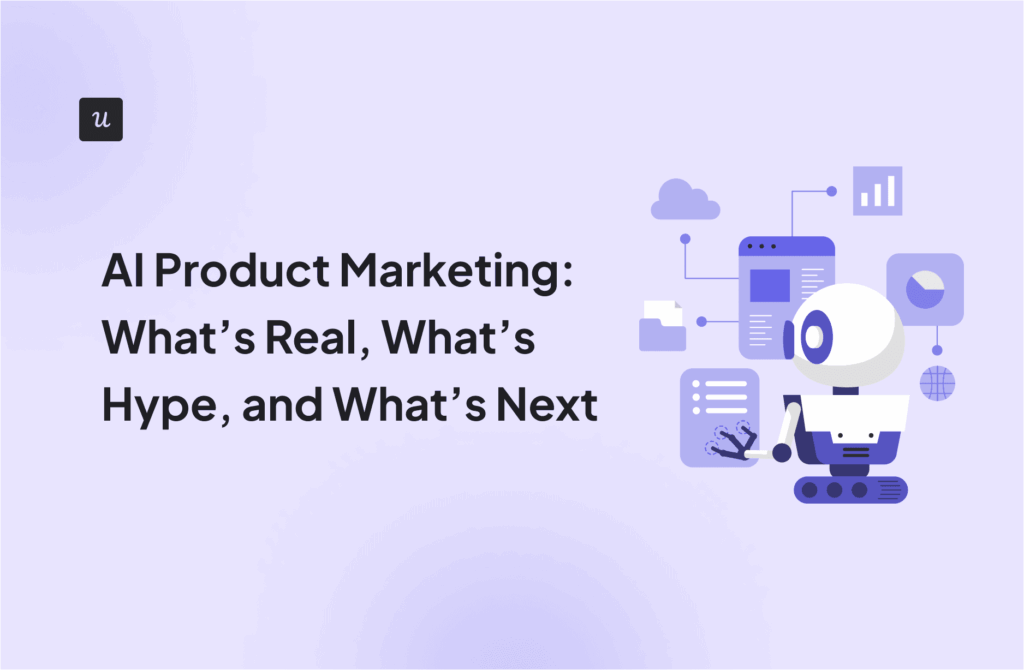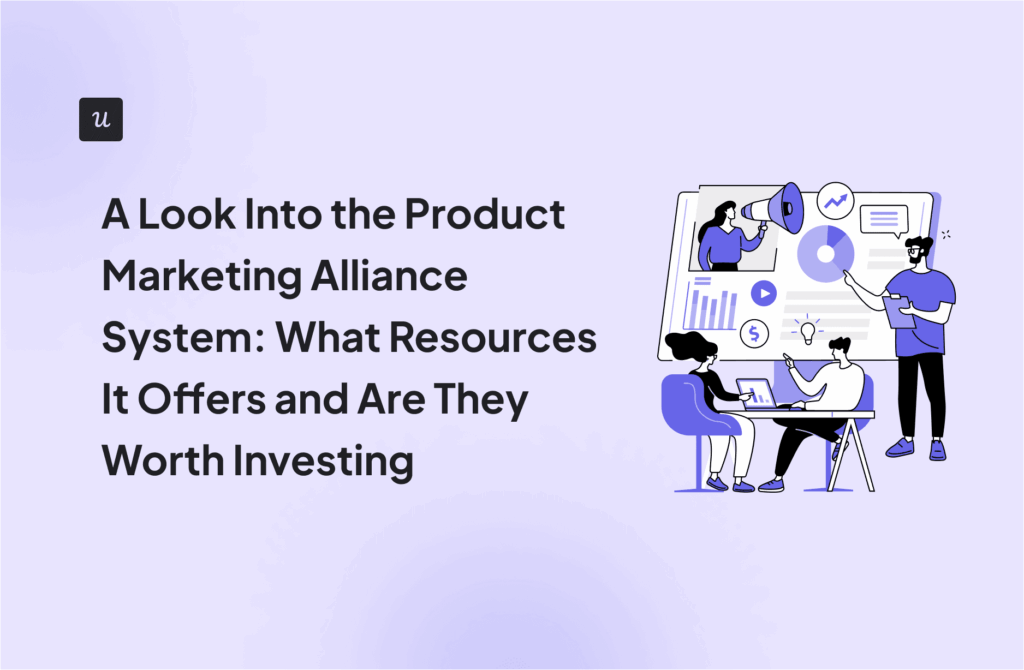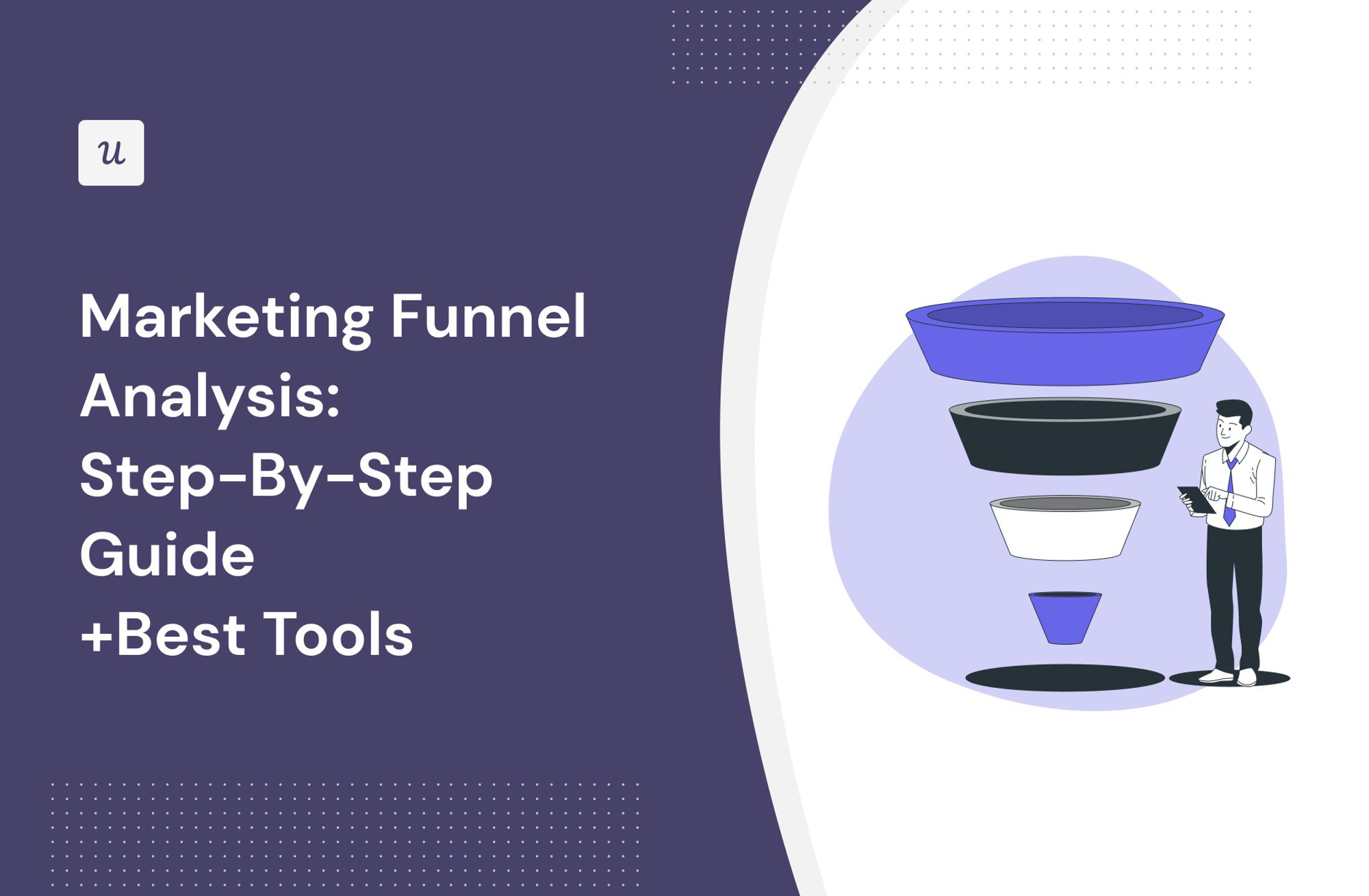
What is marketing funnel analysis? How is it different from sales funnel analysis? Why should you conduct it? And how to do it with available product analytics solutions?
These are the key questions the article discusses, so if you’re after the answers, you’re in for a treat!
Let’s get right into it!
Try Userpilot Now
See Why 1,000+ Teams Choose Userpilot

What is marketing funnel analysis?
Marketing funnel analysis is the examination of the customer’s progress through different stages of their journey, from the moment they discover the product until they become loyal paying customers.
Its purpose is to understand how users behave at different stages in the customer journey and optimize it to create a frictionless experience and improve conversion rates.
Marketing funnel analysis vs. sales funnel analysis
The analysis of marketing funnels and sales funnels focuses on two consecutive stages of the buying process.
The purpose of the marketing funnel is to generate interest in the product and engage prospective users via marketing campaigns until they become Marketing Qualified Leads (MQLs) and/or Product Qualified Leads (PQLs), depending on your GTM strategy. That’s when their interest is serious enough for the sale to happen.
Once qualified by the marketing team, prospects are passed on to the sales team, and that’s when the sales funnel begins. The sales qualify their leads based on their potential (Sales Qualified Leads), and arrange meetings and product demos, which eventually lead to closed deals.
Why is conducting marketing funnel analysis important?
There are a few benefits why marketing funnel analysis is essential for SaaS product success.
Firstly, it allows companies to assess the effectiveness of their marketing efforts. This may include identifying the most effective marketing channels or customer acquisition strategies that drive the most engagement and conversions.
It gets even better.
The insights from marketing funnel analysis allow for more personalized marketing campaigns. Thanks to them, SaaS companies can better tailor their messaging and differentiate based on the preferences of various prospect segments at different funnel stages.
Such personalization, along with a granular understanding of where users experience friction and drop off, helps businesses improve their conversion rates and create a more enjoyable experience for their existing and potential customers.
What are the 5 stages of the marketing funnel?
A typical marketing funnel consists of 5 main stages:
- Awareness – when the user finds out about the product, for example, from an ad or content marketing.
- Interest – when the customer starts researching the product to gather more information about its features and benefits, for example, from product-led content like blog posts, tutorial videos, or webinars.
- Consideration – when the prospect starts seeing the product as a viable solution to their problem after comparing it to other products, reading case studies, reviews and testimonials, watching demos, or using free trials.
- Intent – when the potential customer decides to buy your product, but may need the final nudge to commit.
- Purchase – when the conversion to a paying customer happens and the focus of the marketing efforts shifts towards user retention and loyalty.
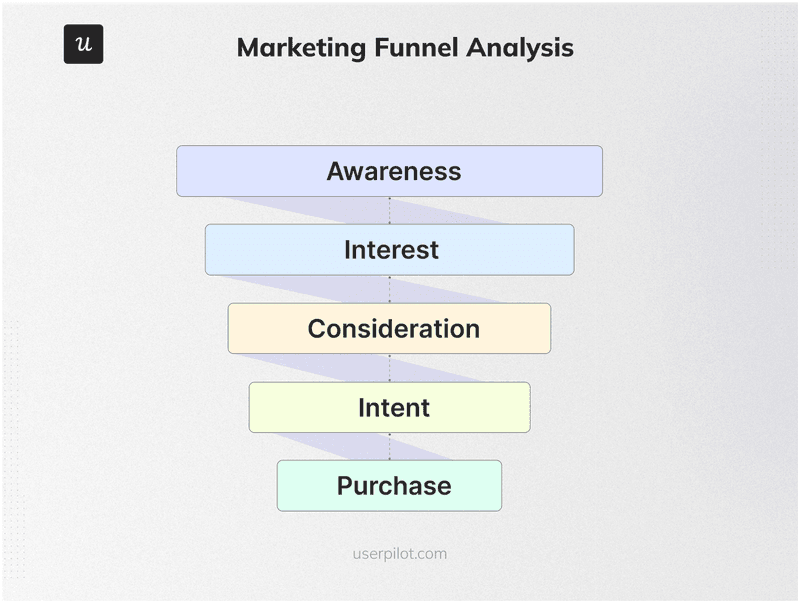
Key steps for analyzing your marketing funnels
With the theory covered, let’s have a closer look at the marketing funnel analysis process, step by step.
1. Create the different buyer personas
Let’s start by creating the user personas. That’s imaginary characters representing your typical customers.
This step is important because your product is likely to be used by different people for different purposes. Consequently, each of them may have a different user journey and respond to different marketing strategies.
A user persona description normally includes information about their:
- Jobs to be done
- Pain points and challenges
- Company details
- Team collaboration needs
- Benefits and gains of using the product
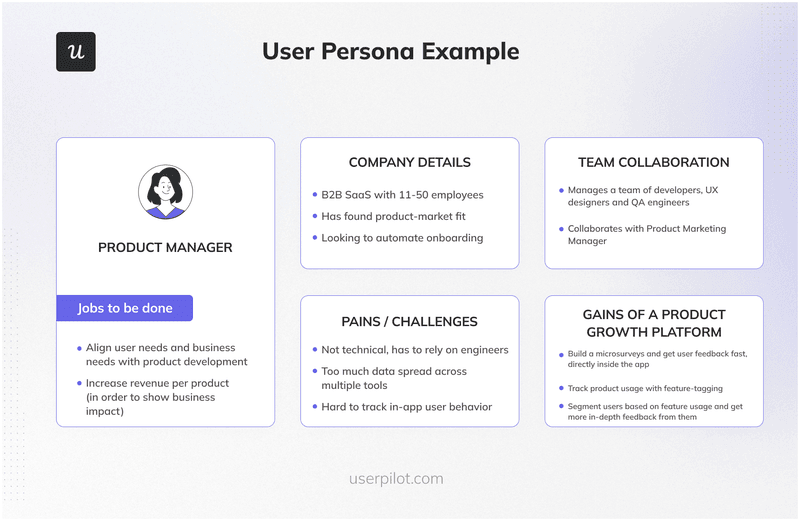
2. Map out the stages of the marketing funnel
Once you identify your user personas, it’s time to map out the user journey for each of them.
While the main stages of the funnel, like awareness or intent, will be the same for all of them, your user persona may engage with the product differently at each of them.
For example, they may:
- Perform different actions at different touchpoints.
- Have different thoughts and feelings.
- Experience different challenges and present different opportunities.
One of the key things you need to do in this step is to choose the conversion events that will indicate that the user progresses from one stage to the other. These could be individual or multiple actions, performed in a fixed or random order.
For example, viewing 3 BOFU blog posts and 3 case studies could indicate that the prospect has reached the consideration stage.
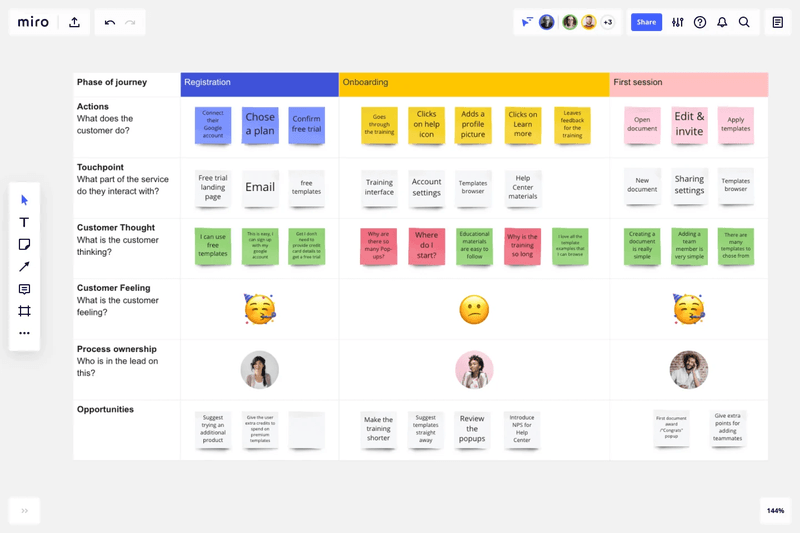
3. Determine the marketing funnel metrics for each stage
To perform marketing funnel analysis, you need to track the right metrics.
These may include:
- Paid ad clicks
- Social media post interactions
- Website visitors and blog post views
- Case study views
- Demo bookings
- MQL to PQL conversion rate
- Activation rate
- PQL to SQL conversion rate
- Free trial conversion rate
- Retention rate
- Customer lifetime value
- CSAT and NPS
- Referrals
- Time to convert
4. Carry out the marketing funnel analysis
The next step is the actual analysis.
Technically, you can do this manually, but the process could be labor-intensive and time-consuming.
It makes way more sense to use a tool with funnel analytics capabilities that will do most of the work for you.
To do so, you need to name the conversion events defined in Step 2, choose the conversion criteria, and filter the data.
Once the report is generated, there are 2 main things to reflect on:
- Conversion and drop-off rates at each stage.
- Time to convert.
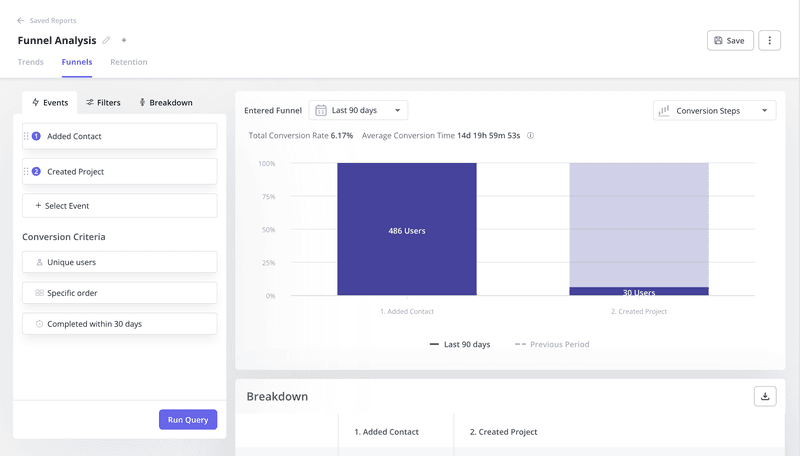
5. Use other analytics reports to thoroughly understand user behavior
While the funnel report can reveal where users are experiencing friction, it may not show you why this is happening.
To find the root cause of friction, you usually need to conduct a more in-depth analysis.
For example, if your demo bookings or free trial sign-ups are lagging despite high initial interest and high engagement with marketing resources, your landing page may need optimization to increase conversions.
To find this out, you can carry out a session recording analysis.
6. Implement changes and monitor their performance
After identifying the causes of users not converting, act on the insights.
How?
Depends on the issue.
For example:
- If users are failing to activate, your onboarding process may need overhauling.
- When they’re failing to convert to paying customers, changing your in-app upsell message microcopy or design could be the solution.
- If there aren’t enough demo bookings – tweak the design of the CTA buttons.
To help you make informed choices at this stage, run experiments, like A/B or multivariate tests, where you test various options simultaneously. That’s how you find the best-performing options.
Is this going to make a difference?
Hopefully. But to be sure, monitor the impact of the changes and make additional changes if necessary.
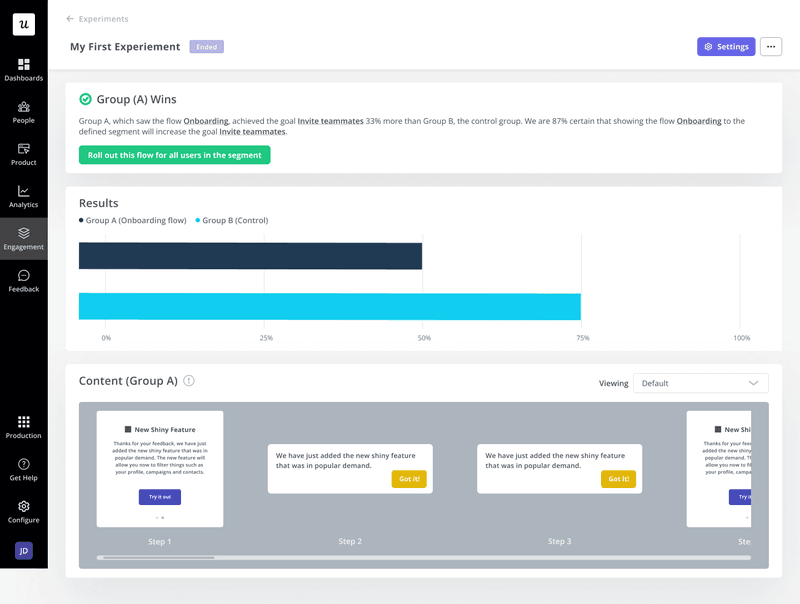
How can marketing teams make use of funnel analysis?
Now that we know how to run funnel analysis, why don’t we look at a few practical ways to use the insights?
Pinpoint which stage of the funnel needs optimization
As mentioned, funnel analysis can reveal the stage that needs optimizing.
A typical funnel chart gets narrower as fewer and fewer users reach the next stage. That’s natural and that’s where the term ‘funnel analysis’ comes from.
That’s also what makes them very intuitive to read: if there is an unnaturally high user drop-off at a particular stage, you will know it immediately.
And if not, the associated metrics, like drop-off rates or time to conversion, will tell you where users are experiencing excessive friction.
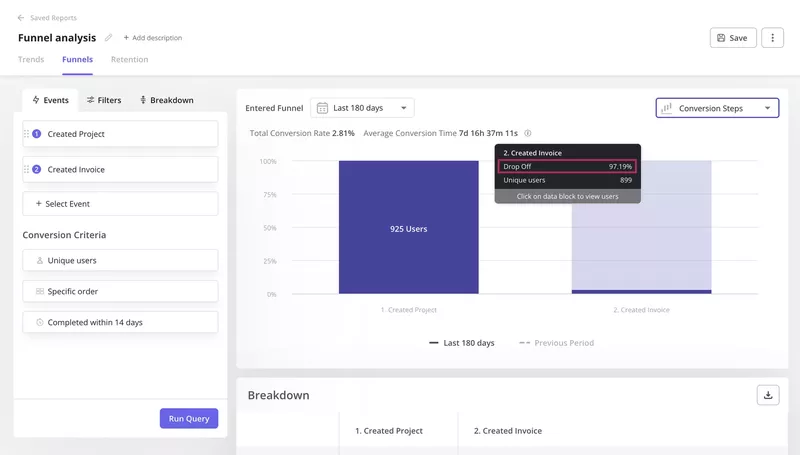
Track conversion rates across the customer journey
In addition to drop-off rates, the funnel analysis allows teams to track the conversion rates at each stage.
That’s how you can evaluate how effective your marketing efforts are – or the optimizations you’ve made to the funnel.
The data is also valuable for forecasting user retention, lifetime value, and revenue.
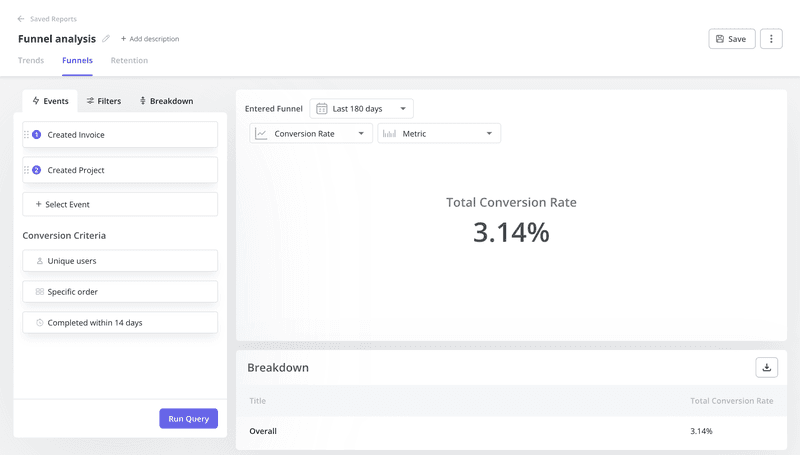
Determine the ideal free trial period
The success of product-led companies depends on their ability to communicate the product value before the user commits to the purchase.
This normally happens through the free plan or a free trial. The idea here is to deliver users enough value to hook them but not enough to satisfy all their needs so that they convert into paying customers.
Marketing funnel analysis can help you figure out the ideal duration of the free trial.
You do it by tracking how long it takes users to reach the activation stage. That’s when they experience product value and start realizing it to achieve their goals.
This is a good starting point for further iterations.
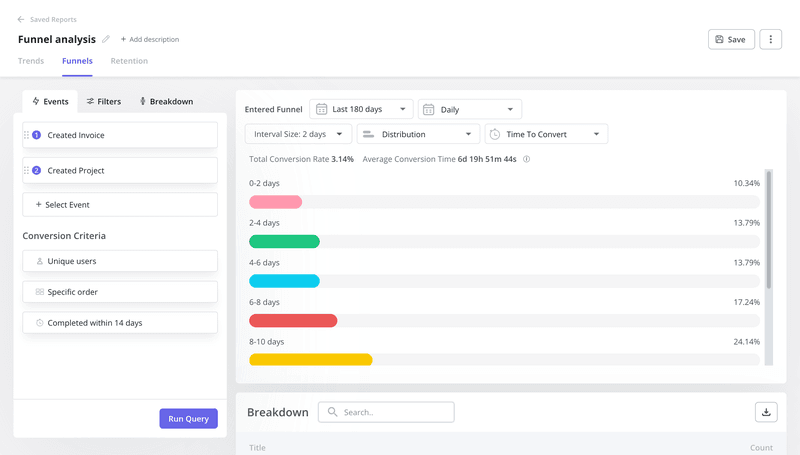
The best funnel analysis tools in the market
Funnel analysis is difficult without the right analytics tool.
Here’s a selection of state-of-the-art tools with funnel analytics capabilities.
Userpilot – recommended for in-app conversion funnel analysis
Userpilot is a product growth platform. Unlike dedicated analytics platforms, it also allows you to collect user feedback and design in-app experiences for user onboarding and engagement.
Conducting funnel analysis in Userpilot is very intuitive. All you have to do is:
- Define the conversion events.
- Determine the conversion criteria, like user vs company level, event order, and time frame.
- Set filters to analyze the right data sets (e.g., by user segments).
- Choose how to visualize the data in the funnel chart.
When it comes to the latter, you have 2 options.
The first one is conversion trends.

The second is the traditional conversion steps view.
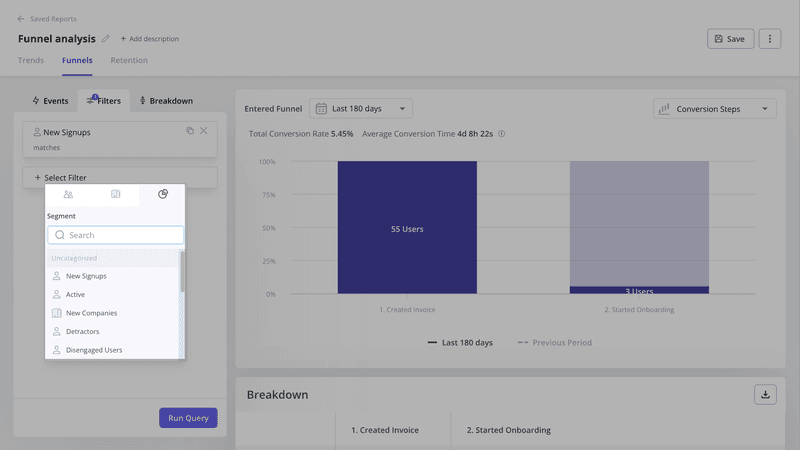
Moreover, Userpilot allows you to break the data down, for example, by the user demographics or the OS they’re using, for more granular insights.
Google Analytics – recommended for free analysis of the digital marketing funnel
Google Analytics is a well-known free analytics tool. Although the latest version allows you to track user behavior inside products, most marketing teams use it for web analytics.
GA can be particularly useful when trying to optimize your landing page conversions as well as paid ad campaigns across different channels.
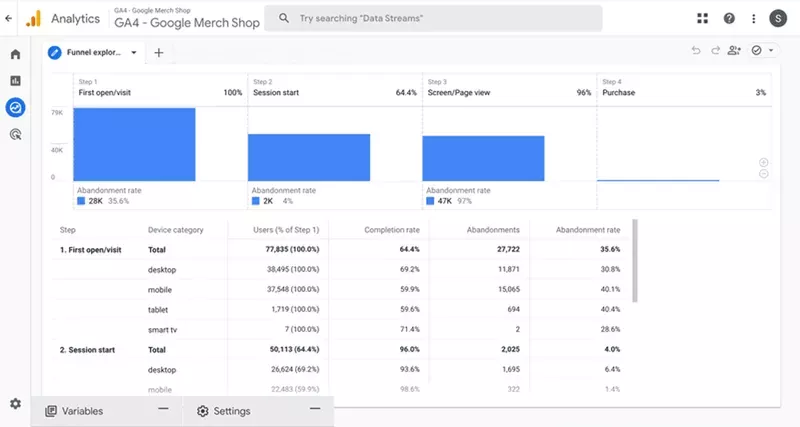
Mixpanel – recommended for performing funnel analysis on mobile apps
Mixpanel is a standalone analytics platform with powerful capabilities, including funnel analysis.
While it doesn’t allow you to collect user feedback or engage users in-app, it has one main advantage over Userpilot: it supports user behavior tracking inside mobile apps. If that’s what you need, Mixpanel is a robust solution.
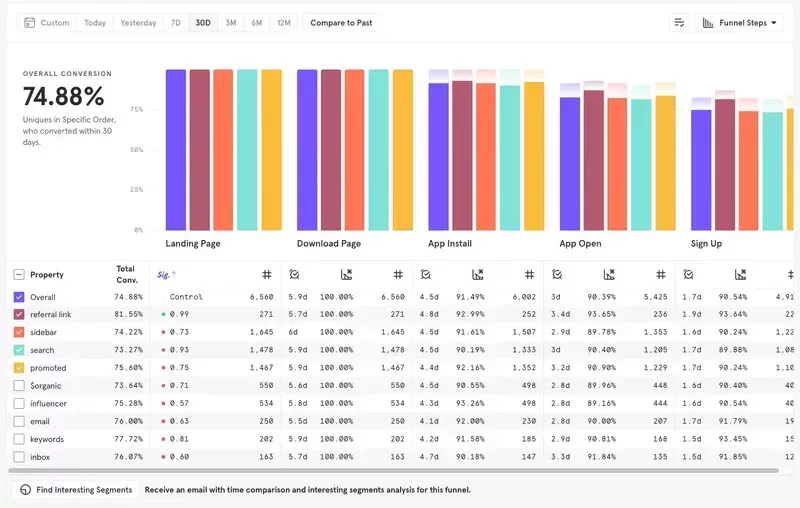
Conclusion
Marketing funnel analysis allows teams to increase conversions at different stages of the user journey. This is critical for SaaS businesses seeking to increase their free-to-paid conversion rate and retain customers over time.
If that’s your case, why not book the Userpilot demo to find out more about how we can help?




